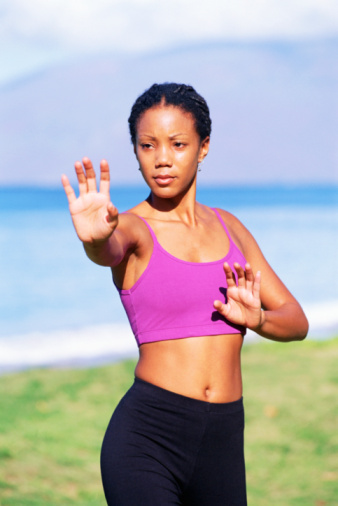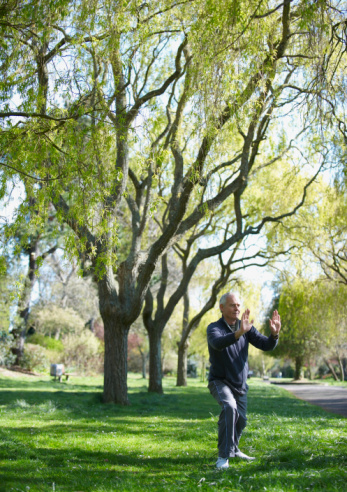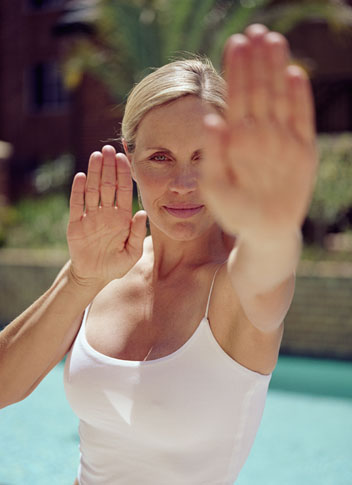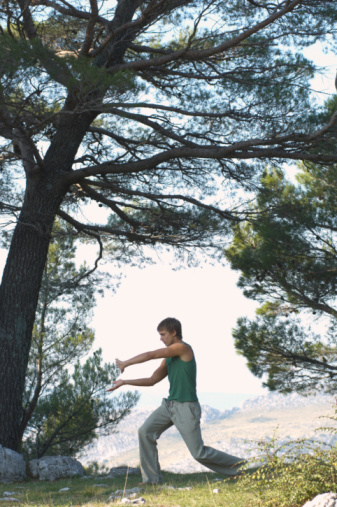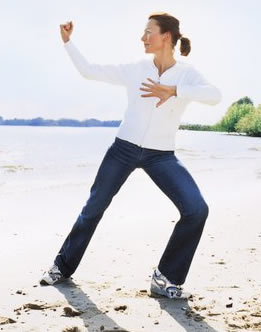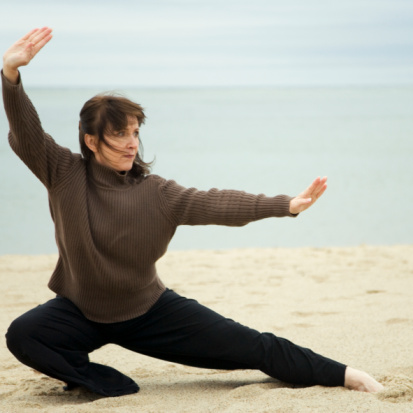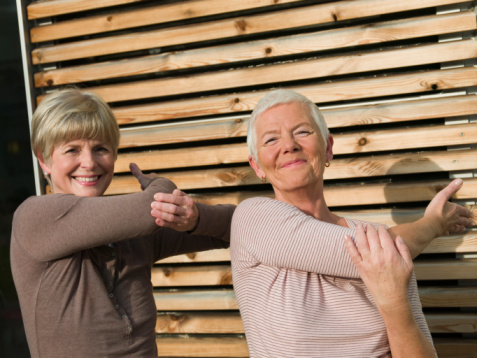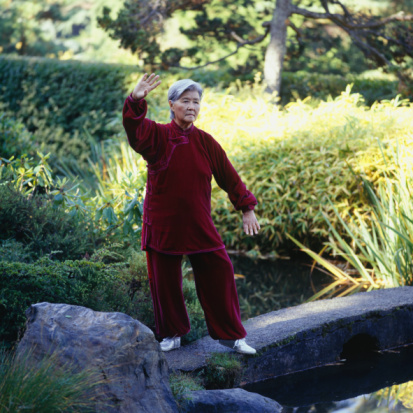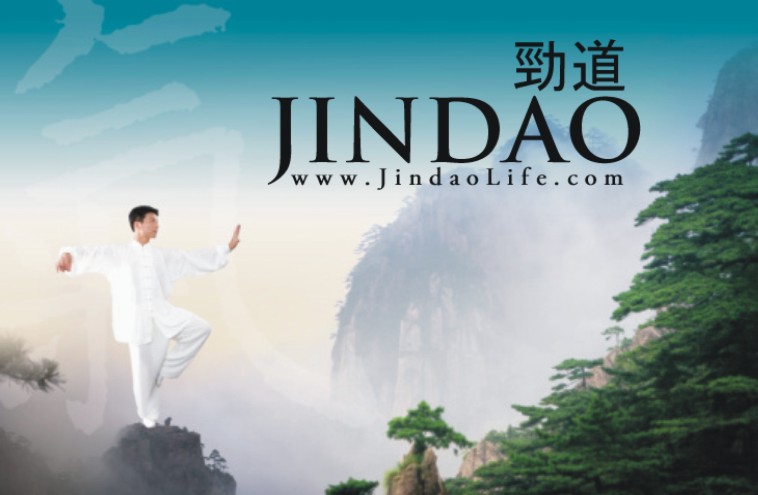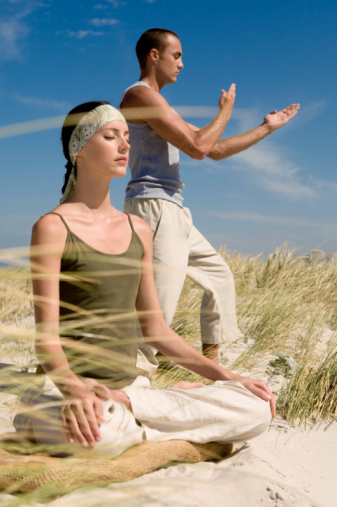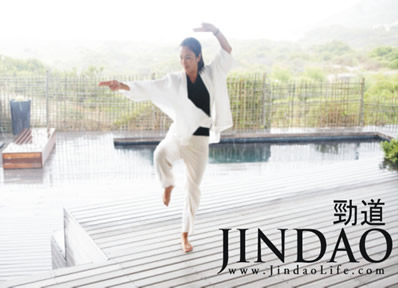Internal Exercises: Neigong, Weigong, & Qigong Practice
by Salvatore Canzonieri
NEW! Qigong Book available with information on healing, purifying, and manifesting.
Click here for more information
The Jindao System's 'Natural Energetic Healing' exercises are known as “Internal” because they contain Neigong ( 內 功 ) - 'internal exercises' and Qigong (氣 功 ) - 'breathing or energy exercises' methodology at their foundation.
Qigong is an ancient practice of movement and meditation that helps heal the body, improve flexibility, balance the emotions, and lift the spirit. The practice involves simple movements and coordinated breathing.
Dao Yin - Chinese Yoga
For many thousands of years, esoteric Chinese Taoists developed physical exercises, breathing methods, and meditation methods that worked the inside of the body to increase one's physical health and spiritual well being; these were called "Dao Yin", which literally means “guiding and stretching”. Dao Yin is also known as "Chinese Yoga", since it similarly used to balance, strengthen, and heal the body through physical stretching and standing postures and guided meditation.
Traditionally and historically speaking, Daoyin practices are stretching exercises, usually combined with breath work. This breath work was called “Qigong” (i.e., ‘Breathing / Energy Skills'). In this way, work was done inside the body to enhance heal, wellbeing, and longevity. The Eight Section Brocade is one of the most well known Dao Yin methods.
Chinese Yoga has three primary goals:
1. To increase the vital energy moving into and circulating within our bodies.
2. To become aware of the subtleties of our body, breath and mind and understand their relationship to one another, as well as how to use this relationship to create a sense of wholeness and peace in our everyday life.
3. To increase our physical flexibility and strength through full ranges of motion, as well as gain smoothness and depth in breathing. This helps to enhance every aspect of our physical, mental and spiritual wellbeing.
Neigong - Internal Exercises
This “internal” work was called “Neigong”. Neigong emphasized coordinating specific body movements with breathing techniques, in specific ways to develop internal strength by ‘harmonizing inner and outer energy'. Internal strength was designed to amplify the effect of physical actions while reducing the effort involved in doing them.
Emphasis was placed on the elasticity of the body, the mobility of the joints, the support of the skeletal structure, the twisting and stretching of the organs and connective tissue, and the proper alignment of the body's parts in order to move as a unified whole.
Qigong and Neigong originated through the Chinese philosophy of Taoism (Daoism) with its first recorded history in the Yi Jing / I Ching (Book of Changes). Qigong has subsequently been influenced by Buddhist, Confucian and medical beliefs. Currently, it is part of Traditional Chinese Medicine (TCM), along with acupuncture and herbal remedies. Its basic premise is to treat the origin of disease in the whole person – body, mind/emotions, spirit – by looking at the imbalance of the entire human system.
Qigong does this through a system [also used in acupuncture] of both pathways that circulate energy, known as meridians, and of vessels that store energy. Qigong exercises are designed to clear blocked energy in different body organs. It is acupuncture without needles, exercises you can do yourself that induce self-healing.
Some of the basic principles of Neigong are:
• the traditional Chinese belief that the body has something that might be described as an “energy field” generated and maintained by the natural respiration of the body, known as “qi”;
• the belief that this ‘qi' (i.e., the life energy inside a person) flows and moves though the body and is assisted by the internal organs;
• the release of external and internal tension is a necessity for cultivating health;
• the letting go of muscular strength to perform specific techniques and postures;
• a heightened self awareness of internal body structure and posture;
• the development of ‘root' by lowering the body's center of gravity, whereby the origin of movement is lowered within the body, which is believed to cause a sinking of ‘qi' or internal energy;
• the combining of the normally separated areas of the body into one integrated, unified, and powerful whole;
• the coordination of specific breathing methods with bodily movements, and the development of an internal peace or calm emotional state;
• the methods involve using the minimum amount of force to achieve maximum results via leverage.
Neigong practices cause the whole body to move in a continuously stretching, expanding and contracting, opening and closing motion. Eventually the body is fluid enough to move very quickly as needed with an absence of central nervous system reaction lag time; great power can be issued with little movement.
This twisting of the body causes the organs to twist as well, which activates the organs to have a detoxification reaction, whereby the liver, intestines, and other organs release toxins that were stored deep in the body so that they can be flushed out. The ultimate aim of this neigong practice was to make the practitioner one with nature, physically, emotionally, and spiritually.
The various Chinese Buddhist and Taoist based martial arts systems that were developed at Wudang, Emei, Kunlun, Shaolin, and other places throughout China at different times incorporated these Neigong techniques and further developed them for use in both health cultivation and “soft” self defense into what today is called the “Neijia” or "internal" family of martial arts. In his book, The Principles of Effortless Power , Peter Ralston explains that, “An internal system . . . concentrates on fundamental, natural principles that are mostly overlooked in other pursuits. For example, an internal system has inherent in it relaxing the whole body, using the whole body all at once, deriving power from the ground, intrinsic strength, the use of Qi or energy circulation throughout the body and that cultivation; breathing, the psychology of the whole matter, perceptive skills, developing the area below the navel”.
The Thirteen Core Concepts
At the heart of all qigong / neigong methods, and the “internal” martial arts that incorporate them, is an intrinsic set of thirteen core concepts. The purpose of these concepts is to teach one to have effortless power through the most efficient and effective mental attitudes and body mechanics. On one level, they involve mental processes and on another level they involve physical activities. In his book, The Principles of Effortless Power , Peter Ralston does a great job of explaining these 13 ideas that are contained within all internal martial arts as “5 Principles and 8 Points” for making the body move more efficiently and effectively:
The Five Principles for being effortlessly effective:
- Being Calm – staying undisturbed in the face of adversity; controlling the thoughts, emotions, and energy of the body so that it is empty and calm. In this way, one can deal with the reality of what is happening rather than reacting to circumstances based on preconceived ideas and habits.
- Relaxing – keeping the mind and the body supple, loose, and open. In this way, the body sets itself naturally using its own connective tissues to bind together was a whole, without locking and tightening any of its parts, such as the joints, tendons, muscles, and so on. Energy is able to flow freely and circulate through the body without impedance. Movements can change freely and spontaneously as necessary.
- Centering – putting physical and mental attention into the center region of the lower abdomen (called the ‘Dantein') so that it governs all body movement. In this way, the body moves as whole, outwardly from this center point; the center directs the movements that the body follows. A centered body becomes more functional and effective because it has structural alignment and balance.
- Grounding – sinking the body weight (after calming the mind and relaxing and centering the whole body) so that it is carried by the pelvis and legs, lowered into the feet, and finally sunk into the earth. To accept the weight properly, the body weight is shifted to only one leg at a time (‘single weighted'), gaining leverage. The body weight is not evenly distributed over both legs at one time (‘double weighted'), which could allow one to easily topple over. During stepping, the weight is relaxed from one foot and then transferred to the other foot, hugging into the earth. In this way, energy is moved down so that the body is rooted and support by the ground.
- Being Whole and Total – the entire body works as one unit, with no gaps within body movements. The limbs do not move independently of the center, they move without tension as a result of the center's movements. In this way, the body and the mind's intention move harmoniously from the center in a complete three dimensional manner.
The Eight Points on structuring body alignment efficiently:
- Align with gravity – align the structure of the relaxed body so that energy is directed downward. In this way, only a minimum amount of energy is used to hold up the body. The body is balanced so that each part below directly supports the parts above it. We align with this falling energy, which is being pulled by gravity.
- Align the Knee, Heel, and Toe – Movement of the knee is directed down the leg and pressing into the heel of the foot. The front of the knee point in alignment with the toes of the foot, not going past them in any direction. As the foot turns in or out, so too does the direction of the knee. Also, the pelvis stays in between the feet. In this way, maximum leverage is achieved.
- Shifting the Weight – One leg is relaxed before it moves towards the other and compresses into the heel. With one foot free, the steps or the waist and legs can be adjusted without some preliminary movement. The center of the body presses into the foot, which presses itself away from the earth. In this way, the weight is shifted as if dropping into the ground and the body is compressed or squeezed, moving as if it is coming up from the ground (getting great power from the compression). The stepping is coordinated with the breathing, which is sunk into lower abdomen immediately before the foot is pressed.
- Unlocking the Body – the joints of the body are allowed to bend and rotate with ease so that they can relax and align themselves to the way they naturally function. The feet are relaxed so that they act as a suction cup that spreads on the surface they are on and become sensitive to balance; the pelvis is relaxed so the hip joints open so that it drops down and stays between the two feet; the upper body is relaxed so that the shoulder joints open and loosen, keeping the shoulders and elbows pointing downwards; and the joints are relaxed and opened so that the body's balance is maintained and it is not effected by occurring forces.
- Integrate, Unify, and Coordinate All Body Parts – When the various parts of the body move tightly without whole body harmony, the body loses power, balance, coordination, and more. When the major sections of the body move with unification and coordination, it is called the ‘Six Unifications'' or ‘Six Harmonies' ( 六合 - ‘Liuhe'). The lower and center parts take priority over and initiate movement of the upper parts. The moving center allows the foot to move out in relationship with the hand, the hips to turn with the shoulder, and the elbows and knees to move together. The nose always points in the same direction with the naval. In this way, the head turns at the same time as the pelvis. The pelvis is kept directly under the upper body and over the feet so that it is centered between the upper and lower body. Finally, the mind, energy, and body moves as one unit, with energy circulating through the body, permeating all its parts, and then becoming heard and understood so that it can be transcended.
- Functional Priorities – the upper body is subservient to the lower body and the inner center directs the outer body parts. The center then has the highest priority since it creates all movement. Likewise, energy has priority over physical movement.
- Creating the Opening for Intrinsic Strength – making all the relaxed body connections and alignments allow its intrinsic strength to be used naturally and expressed with effortless power. Movement is propelled loosely from the center so that the limbs are emptily projected outwards with a minimum amount of force. As the hands go up, strength is then concentrated away from the arms down into the legs and feet, which then can freely project a maximum amount of power back up through the relaxed arms. Being that the joints are open and the body tissues are loosened, the limbs can elongate greatly and the extending energy can strike from a greater distance than is expected.
- Being Three-Dimensional in Eight Directions – the movement of energy from the center radiates freely and equally in all directions (i.e., front, rear, left, right, up, down, inside, and outside).
Self Defense through 13 Healing Postural Movments
Eventually self defense oriented footwork and hand movements developed over time that exemplified these 13 core concepts. These associated movements often were called the “Shi San Shi” (十三式), which can mean “13 Forces” or “13 Skills” (十三功 ). Some called them the "13 Powers” or “13 Postures” (十三勢), as well as 13 Tactics, Entrances, Movements, or Energies. The 13 Shi are not actually 13 different and distinct postures, it really means 13 basic skills or attributes for advance study. These 13 Shi were further developed under different names depending on where and when the material was being taught: the 8 Directions and 5 Steps; the 8 Powers and 5 Elements; the 8 Gates and 5 Directions; and so on.
The 13 Shi allowed one to master using effortless power for self defense. The key to achieving this effortless power was to first master rooting through single weighted postures. Once single weighted rooting was mastered, then what was next mastered was rooted movement while the body is relaxed. To achieve this mastery, the body is kept fully relaxed and tension-less by dropping the shoulders and elbows, relaxing the lower trunk, and letting everything be naturally pulled downward by gravity so that all the body's weight is felt in the feet. It was essential to be able to retain one's root while stepping forward and backward; in other words, to walk and shift positions while remaining weighted, or rooted.
To defeat any attackers with effortless power one must bring them out of their range of balance. By evading their attack, they must to over extend to continue to issue force. Next, at the moment of contact, either on defense or offense, the body's weight must be rooted straight into the ground. The body exhales while the supporting foot is being driven into the ground, allowing the weight to fully drop down into that foot. Thus, the body can then achieve maximum leverage to uproot an attacker by unifying the body's weight into a single space under this foot. When the weight is dropped through the feet into the ground, our body is more stable than any moving human force that seeks to come into contact with our body, which allows the body to act as a lever to uproot an attacker.
During stepping, it is important that the point on the foot where the most weight is pushing into the floor is centralized. Once you over extend and use brute force you come out of this strong root, and your power decreases congruently. Also, it is important to understand that by relaxing, staying calm, and "not trying", you can master self defense and uproot an opponent with effortless power. If the opponent enters your space, no matter what technique he is executing, he will be uprooted and toppled easily. The less brute force you use, the more you instead can discharge your mind/intention (Yi) to move others. The weight can then be dropped at will while in any posture or movement.
The next step of great importance is learning to turn at your central axis or waistline. When attacked, you can simply turn your Axis and uproot them with little to no force when rooted. When the force is initiated in our direction we relax patiently and begin turning our axis/waist slightly to redirect or deflect their energy. The hands guard the centerline while simultaneously acting in defense and offense.
Furthermore, internal Chinese martial arts feature such concepts as:
- Maximum power is used with a minimum of effort because the muscles, ligament, tendons, and will are focused to exercise in coordination with each other;
- “Stopping the Fight”, preventing or evading an incoming attack rather than engaging in sports-like one on one trading of blows;
- Evasive maneuvers are used to get out of the way, much like a bull fighter moves out of the way of a charging bull with horns;
- Every technique is simultaneously both offensive and defensive (there is no direct hard blocking first and then a counterattack);
- No first initiation of movement, the attacker initiates, but the defender's movements quickly hit the attacker before his attack can be completed;
- Striking with punches and kicks is deemphasized, instead the emphasis is on taking down an opponent by using the legs, arms, or even the whole body to evade, trap, unbalance, or trip an attacker;
- Often the foot is used during self defense to step on an opponent's foot to help unbalance the attacker;
- All movements are based on pointing, swinging, or both together.
Today, the martial arts of Bagua Zhang, Taiji Quan, and Xing/Xin Yi Quan are the best known of the Neijia arts and are often practiced together. The origins of these so-called “Big Three Internal Martial Arts” are both mysterious and controversial. These convoluted origins are often interconnected and interrelated and span through many other Chinese martial arts. Often times some aspects of one style's boxing routines served as a root to the development of another style, though their relationship may have become long forgotten today.
During the Qing Dynasty (1644 to 1912), many famous Chinese martial artists arose who practiced not only all three arts of Bagua, Taiji, and Xingyi, but also some form of Long Fist Boxing as well, such as Shaolin Quan and Tongbei Quan. One such practitioner, Sun Lu Tang ( 孫祿堂 , 1861-1932), noticed that there were many similarities between the movements, body mechanics, and core ideas of the boxing routines of the three internal arts and was able to develop a practice that successfully integrated their movements. Sun Lu Tang was renowned as a master of the Chinese Neijia (internal) martial arts and was best known for developing the Sun style Tai Chi Chuan, which contains elements of Chen Bagua Zhang, Hao (Wu) Taiji Quan, and Hebei Xing Yi Quan.
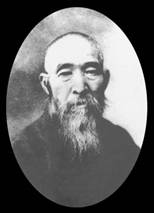
Sun Lu Tang
After mastering Xingyi Quan and Bagua Zhang in Hebei , Sun Lu Tang next studied Yi Jing theory and Emei qigong in the Sichuan Mountains and Taoism, qigong, and martial arts in the Wudang Mountains . In his writings, Sun Lutang said that internal martial arts shared the following characteristics:
1. The use of a relaxed body to coordinate leverage as opposed to the use of brute strength.
2. The development, circulation, and expression of qi within the body.
3. The application of Daoyin, Qigong, and Neigong principles of bodily movement.

